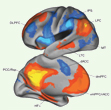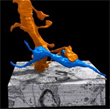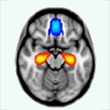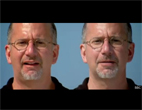Monday, 10 August 2015
What’s running our show?

Deric Bownds, director of the Biology of Mind program at the University of Wisconsin-Madison, recently gave a lecture at this institution’s seminar series on chaos and complexity. The lecture was entitled “Upstairs/Downstairs in our brains – What’s running our show?” (You can find the full text by following the link at the bottom of this post.) Its subject was the increasingly common distinction, in the literature on the brain, between bottom-up and top-down control. This literature also employs other metaphors for opposing processes in the brain, such as the famous System 1 (fast and unconscious) versus System 2 (slower and conscious), the “upstairs/downstairs” metaphor in the title of Bownd’s lecture, and the distinction between the attention network (the parts in blue in the illustration here) and the default mode network (the parts in orange). (more…)
From Thought to Language | Comments Closed
Saturday, 18 July 2015
Microscopic Synapses and Giant Microscopes

More and more courses are being offered for free online by prestigious universities. Many of these courses deal with various aspects of the cognitive sciences. One such course is “The Fundamentals of Neuroscience”, from Harvard University (see first link below). This course includes various multimedia features, including an excellent 30-minute documentary video entitled “Connectomics: Big Microscopes & Tiny Synapses” (second link below). This video presents the research being done by Professor Jeff Lichtman and his colleagues in his laboratory, who are using images of real human brains to try to map the connections between their neurons—the synapses. (more…)
From the Simple to the Complex | Comments Closed
Tuesday, 30 June 2015
The Physiology of Expanded Consciousness

The results of some studies are exactly what you would have predicted, but that doesn’t make them any less interesting. For example, the study reported in the link below found that taking psilocybin (the psychoactive substance in “magic mushrooms”) puts the brain in a state that is conducive to freer associations, somewhat as in dreams. (more…)
The Emergence of Consciousness | Comments Closed
Tuesday, 9 June 2015
The McGurk Effect: An Auditory Illusion

This week’s post will be brief, so that you can get out and enjoy the start of summer and the restoratjve effects of nature, but the subject is very intriguing.
Have you ever heard of the McGurk effect? It’s an auditory illusion that shows just how much our brains construct our auditory perceptions not only from what we hear but also from what we see.
In the case of spoken words, what we see is the mouth of the person who is talking to us. (more…)
The Senses | Comments Closed
Wednesday, 27 May 2015
The Evolution of Language, From Animals to Analogy

Language is a communication tool that relies very heavily on analogy. In fact, according to Douglas Hofstadter and Emmanuel Sander, authors of Surfaces and Essences: Analogy As the Fuel and Fire of Thinking (2013), analogy plays a fundamental role in the very way we think.
Hofstadter now admits that when he wrote his book Gödel, Escher, Bach: An Eternal Golden Braid, which is full of daring analogies and became something of a cult in the 1980s, he had not really explored all the implications of analogy as a way of transferring knowledge from one field to another. Today, however, he regards analogy as central to all human experience. (more…)
From Thought to Language | Comments Closed







